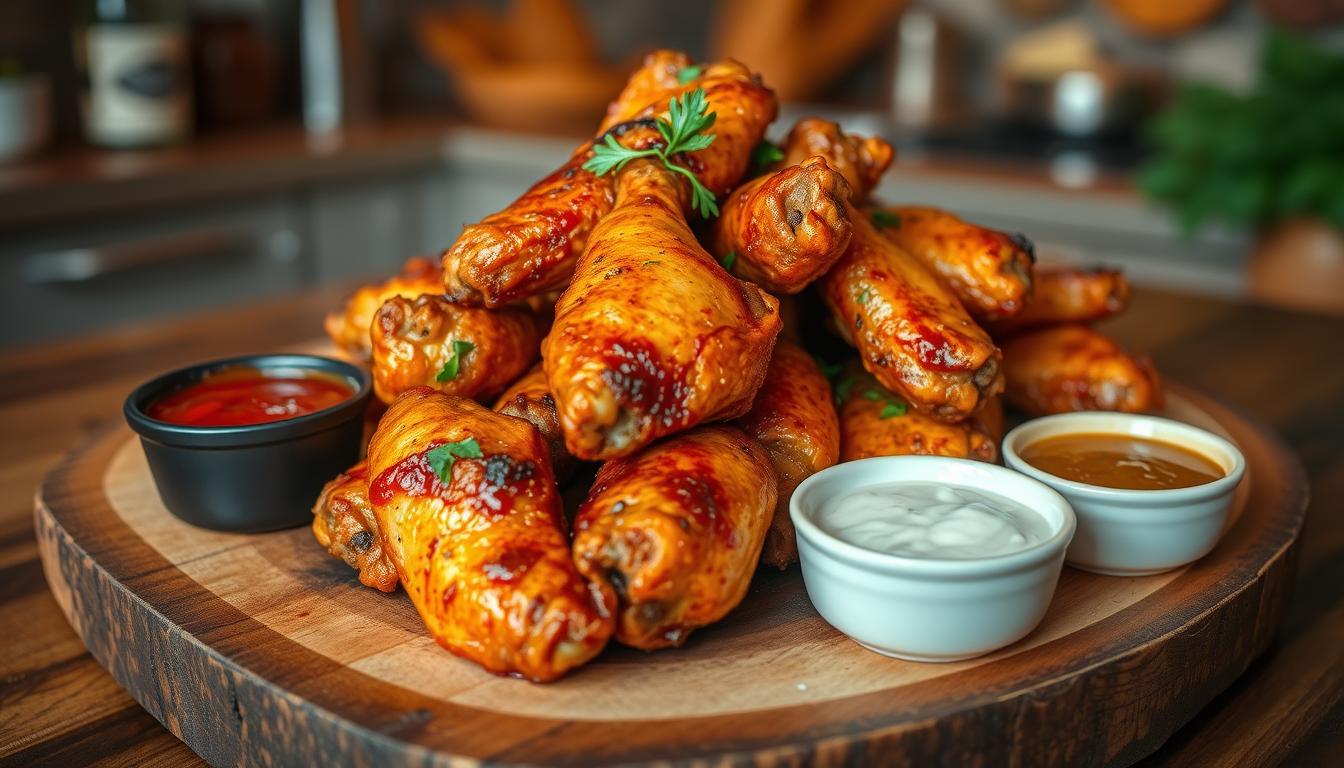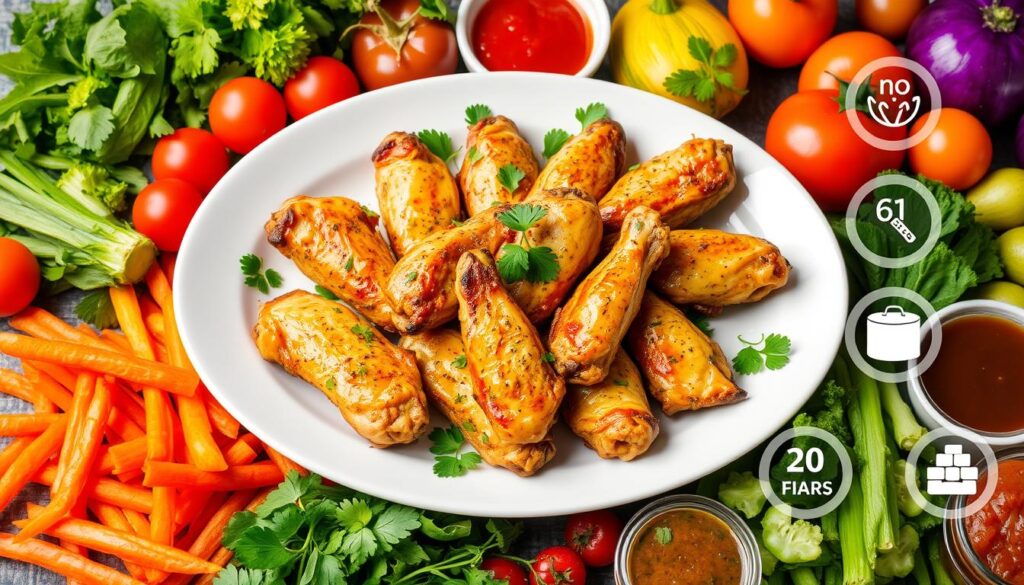Chicken wings are a favorite in many homes and restaurants. They offer a tasty and flexible protein choice. But, it’s key to know their calorie count to keep our diets balanced. This article looks into the calories in baked chicken wings, their nutrient makeup, and what affects their calorie content.
Key Takeaways
- Baked chicken wings are a relatively low-calorie option compared to their fried counterparts.
- The calorie count of baked wings can vary based on factors like portion size, seasoning, and cooking method.
- Understanding the nutritional profile of baked wings can help individuals make informed dietary choices.
- Incorporating baked chicken wings into a balanced diet can provide valuable protein and other essential nutrients.
- Proper preparation techniques, such as using healthier coatings and monitoring portion sizes, can further reduce the caloric impact of baked wings.
Understanding Chicken Wing Nutrition Basics
Chicken wings are more than just tasty. They’re packed with nutrients that help keep you healthy. Knowing what’s in them can help you make better choices.
Essential Nutrients in Chicken Wings
Chicken wings are full of important nutrients. Here’s what you’ll find:
- Protein: They’re a top source of protein. This is key for muscle repair and growth.
- Vitamins and Minerals: You’ll get vitamins B6, niacin, phosphorus, and selenium. These are vital for your body’s functions.
- Healthy Fats: Chicken wings have fat, but some of it is good for your heart when eaten in small amounts.
Protein and Fat Content Overview
The protein and fat in chicken wings depend on how they’re cooked and how much you eat. A single wing has about 6 grams of protein and 4 grams of fat. Remember, the size of your serving matters for a healthy diet.
Serving Size Considerations
| Serving Size | Calories | Protein (g) | Fat (g) |
|---|---|---|---|
| 1 chicken wing (50g) | 87 | 6 | 4 |
| 3 chicken wings (150g) | 261 | 18 | 12 |
| 6 chicken wings (300g) | 522 | 36 | 24 |
As you can see, eating more wings means more calories, protein, and fat. It’s crucial to watch your portion sizes to stay healthy.
Baked Chicken Wings Calories: Complete Breakdown
Understanding the calorie count of baked chicken wings is key for those on a diet or seeking healthier options. Let’s explore the calorie content in baked wings.
A single serving of baked chicken wings, about 3 to 4 pieces, has around 220-280 calories. This number can change based on wing size, seasoning type, and cooking method.
| Nutrient | Amount (per serving) |
|---|---|
| Calories | 220-280 |
| Protein | 25-30 g |
| Fat | 14-18 g |
| Carbohydrates | 0-2 g |
The main parts of baked chicken wings are protein and fat. They have about 25-30 grams of protein per serving, great for muscles. The fat, 14-18 grams per serving, gives essential fatty acids.
The calorie count can also be affected by seasonings, sauces, or coatings. Choosing low-calorie seasoning options and avoiding heavy sauces can help manage calories.
“Understanding the calorie breakdown of baked chicken wings is the first step towards making informed and healthier choices.”
Comparing Baked vs. Fried Wing Calorie Content
Chicken wings can vary in calories based on how they’re made. Baked wings are a healthier choice compared to fried ones. They have fewer calories but still taste great.
Health Benefits of Choosing Baked Wings
Baked wings are better for you because they’re not fried. This method lets the chicken’s natural taste come through. It also cuts down on fat and calories. Choosing baked wings can save you up to 50% in calories, which is good for your weight.
Caloric Difference Between Cooking Methods
- A single serving of baked chicken wings (about 3-4 wings) has 200-250 calories.
- On the other hand, the same amount of fried chicken wings can have 350-400 calories or more. This depends on the recipe and how they’re fried.
The big difference in calories between baked and fried wings shows why healthier cooking is better. Baked wings are not only lower in calories but also more nutritious. They’re a better choice for those who care about their health and wellness.
Factors Affecting Calorie Count in Baked Wings
Several factors influence the calorie count of baked chicken wings. Knowing these can help you enjoy your favorite dish in a healthier way.
Wing Size Matters
The size of chicken wings affects their calorie count. Bigger wings have more meat and skin, leading to more calories. Choosing smaller or medium wings can lower your calorie intake.
Skin-on vs. Skinless
The presence of skin on wings is key. Skin-on wings have more fat and calories. On the other hand, skinless wings are lower in calories but still tasty.
Marinade Impact
The marinade or seasoning also matters. Marinades high in sugar or oil add calories. But leaner, herb-based marinades keep calories down.
| Factor | Impact on Calorie Count |
|---|---|
| Wing Size | Larger wings = higher calories |
| Skin | Skin-on wings = higher calories |
| Marinade | Sugar/oil-based marinades = higher calories |
Understanding these factors helps you make better choices when baking chicken wings. You can enjoy them as part of a healthy diet.
Popular Seasonings and Their Caloric Impact
Choosing the right seasoning for baked chicken wings can affect their calorie count. Knowing the nutritional values of common wing sauces, dry rubs, and low-calorie seasonings helps you make better choices. This way, you can enjoy your wings without worrying about your diet.
Common Wing Sauce Calories
Classic wing sauces like Buffalo, barbecue, or honey mustard can add a lot of calories. A typical serving of wing sauce calories can be between 50 to 150 calories per tablespoon. This depends on the brand and ingredients. Choose lighter, vinegar-based sauces or try low-calorie seasoning options to keep your wings healthier.
Dry Rub Nutritional Information
Dry rubs add flavor to baked wings without extra calories from sauces. But, the dry rub nutrition can still affect the calorie count. Be careful with dry rubs that have sugar or high-calorie ingredients. Instead, choose simple, herb-based blends to keep your wings low in calories.
Low-Calorie Seasoning Options
- Garlic powder
- Onion powder
- Paprika
- Cayenne pepper
- Chili powder
- Lemon pepper
- Herbs like rosemary, thyme, or oregano
These low-calorie seasonings add flavor to your baked wings without many calories. Try different mixes to find the perfect blend that tastes great and is good for you.
Understanding how popular wing seasonings affect calories helps you enjoy baked chicken wings healthily. You can make choices that keep your diet balanced and nutritious.
Portion Size Guide for Weight Management
Keeping a healthy weight is all about portion control. This is especially true for baked chicken wings, which can be high in calories if not eaten wisely. To help you manage your wing portion control and weight management goals, here are some serving size guidelines.
The right portion size for baked chicken wings is usually 3-4 wings per person. This amount is enough for a satisfying snack or meal without overdoing it on calories. Remember, the calorie count can change based on wing size, seasonings, and cooking method.
| Portion Size | Calories | Protein | Fat |
|---|---|---|---|
| 3 baked wings | 220 calories | 24g | 13g |
| 4 baked wings | 290 calories | 32g | 17g |
Being mindful of your wing portion control and eating them with a balanced meal can help. This way, you can enjoy the taste without ruining your weight management plans. It’s about finding a balance between satisfying your cravings and staying healthy.
“Portion control is the key to enjoying your favorite foods while keeping your weight in check.”
So, when you’re craving baked chicken wings, remember these serving size tips. With a bit of calorie counting and mindful eating, you can satisfy your cravings while supporting your health and fitness goals.
Nutritional Benefits of Baked Chicken Wings
Baked chicken wings are not only tasty but also full of good nutrients. They are great for a healthy diet because of their many health benefits.
Protein Content and Muscle Building
Chicken wings are a top source of protein, key for muscle growth and repair. Eating just a few baked chicken wings can give you a lot of protein. This makes them perfect for those trying to build muscle.
Essential Vitamins and Minerals
Baked chicken wings also have important vitamins and minerals. They have vitamin B6, niacin, phosphorus, and selenium. These nutrients help keep you healthy and feeling good.
| Nutrient | Amount per Serving (100g) | % Daily Value |
|---|---|---|
| Protein | 30.5g | 61% |
| Vitamin B6 | 0.5mg | 25% |
| Niacin | 6.6mg | 41% |
| Phosphorus | 222mg | 22% |
| Selenium | 27.2mcg | 39% |
Eating baked chicken wings can help you reach your health goals. They offer wing nutrition benefits like protein for muscle growth and vitamins in wings.
Tips for Reducing Calories in Baked Wings
Craving delicious chicken wings but watching your calorie intake? No need to deprive yourself! With a few simple tweaks, you can enjoy flavorful low-calorie wing recipes that won’t derail your health goals. Let’s explore some practical calorie reduction techniques for baked chicken wings.
- Opt for Lean Cuts: Choose drumettes or flats, which are naturally leaner than the wing tip.
- Ditch the Skin: Removing the skin can save you a significant number of calories.
- Use Minimal Oil: Lightly coat the wings with a small amount of oil or non-stick cooking spray to achieve a crispy texture without excess fat.
- Embrace Dry Rubs: Flavorful healthy wing prep with spices and herbs can add tons of taste without the extra calories from sauces.
- Bake at High Heat: Cooking the wings at 400°F or higher can help them crisp up without the need for frying.
- Watch Portion Sizes: Stick to a reasonable serving size, such as 4-6 wings, to keep your calorie intake in check.
By incorporating these simple strategies into your low-calorie wing recipes, you can satisfy your cravings while maintaining a nutritious diet. Enjoy the flavor-packed goodness of baked chicken wings without the guilt!
“The key to enjoying wings without packing on the pounds is to focus on healthy wing prep and calorie reduction techniques.”
Best Practices for Healthy Wing Preparation
Preparing delicious and healthy baked chicken wings is an art. It needs careful attention to detail. Here are some key tips and techniques to help you get it right.
Recommended Cooking Temperatures
It’s important to cook at safe cooking temps for safety and texture. Bake your wings at 400-425°F (204-218°C) for 30-40 minutes. Flip them halfway through. This method keeps them juicy and crispy.
Healthier Coating Alternatives
Move away from high-calorie coatings and try low-calorie coatings. Season your wings with spices, herbs, and a bit of olive oil before baking. You can also use panko breadcrumbs or cornmeal for a crunchy coating.
By following these tips, you can enjoy tasty baked chicken wings without harming your health. The secret to healthy wing cooking is finding the right balance between taste and nutrition.
Incorporating Wings into a Balanced Diet
Baked chicken wings can add flavor and nutrition to your meals. It’s important to pair them with side dishes that offer a variety of vitamins, minerals, and macronutrients.
When you plan meals with baked wings, aim for a balanced meal planning approach. This means balancing the protein-rich wings with sides like roasted vegetables, fresh salads, or whole grains.
- Pair baked wings with roasted broccoli, Brussels sprouts, or asparagus for a nutrient-dense meal.
- Serve wings alongside a hearty quinoa or brown rice dish to boost fiber and complex carbohydrates.
- Complement the wings in diet with a fresh, colorful salad or sautéed greens to increase your intake of essential vitamins and minerals.
By combining baked chicken wings with nutrient-rich sides, you can enjoy their flavor while ensuring a balanced and nutritious meal.
| Baked Wing Pairing | Nutrient Benefits |
|---|---|
| Roasted Vegetables | High in fiber, vitamins, and minerals |
| Whole Grain Sides | Rich in complex carbs, fiber, and B vitamins |
| Fresh Salad | Packed with antioxidants and phytonutrients |
By using these balanced meal planning strategies, you can enjoy baked chicken wings as part of a healthy diet.
Conclusion
The calories in baked chicken wings can change based on several things. These include the serving size, seasonings, and how they’re cooked. Knowing the basics about chicken wings’ nutrition helps you enjoy them in a healthy way.
Whether you like the simple baked wing or a spicier version, watch your portion sizes. Choose healthier cooking methods to balance taste and calorie control. It’s all about moderation and a balanced diet.
Understanding the calories and nutrients in baked chicken wings helps you make better choices. This way, you can enjoy their taste without harming your health. With the right knowledge, you can indulge in baked chicken wings while staying healthy.
FAQ
How many calories are in baked chicken wings?
Baked chicken wings have different calorie counts based on size, skin type, and seasonings. On average, a single wing without skin has about 40-50 calories.
What are the essential nutrients found in chicken wings?
Chicken wings are packed with protein, about 7 grams per wing. They also have important vitamins and minerals like iron, zinc, and B vitamins.
How does the calorie count differ between baked and fried chicken wings?
Baked wings have fewer calories than fried ones. Fried wings can have up to twice as many calories because of the extra fat and oil.
What factors affect the calorie count of baked chicken wings?
Several things can change the calorie count of baked wings. These include wing size, skin presence, and any sauces or seasonings. Larger wings, skin-on, and high-calorie sauces increase calories a lot.
How can I reduce the calories in baked chicken wings?
To cut calories, try these tips: remove the skin, use a dry rub, bake on a wire rack, and control portion sizes.
What are the nutritional benefits of baked chicken wings?
Baked wings are high in protein, which helps muscles. They also have iron and zinc. Without too much fat or sauce, they’re a healthier choice.
How can I incorporate baked chicken wings into a balanced diet?
Enjoy baked wings in moderation with healthy sides like roasted veggies or salads. Be careful with portion sizes and avoid high-calorie sides.


